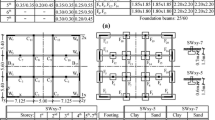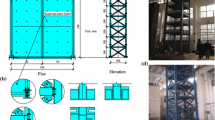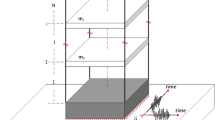Abstract
The frequency content of earthquake ground motions shows the different influences on the performance of the structural response while the Soil-Foundation-Structure Interaction (SFSI) is considered. In this study, the periods with crucial effects on the response of a structure are quantitatively detected by considering the wavelet energy spectrum. The effects of SFSI under plane-strain conditions are studied using the substructure approach for the structural frames supported by rigid foundations embedded into a homogeneous, isotropic and elastic half-space. The effective-mass formulation is developed for the system with and without considering SFSI. Three ranges of periods on the energy spectrum of the response ratio are identified. The proposed ranges of periods on the energy spectrum and the band of possible predominant periods of free-field motion illustrate the beneficial or the detrimental effects of Soil-Foundation-Structure (SFS) system by determining the ratio of base-shear or structural inter-story drifts for flexible base structure and fixed base structure cases.
Similar content being viewed by others
References
Abry, P. (1997). Ondelettes et turbulence, Multire’solutions, Algorithmes de De’composition, Invariance De’chelles, Diderot Editeur, Paris, France.
Amini, F. and Shadlou, M. (2010). “Effects of recoded free-field motion on the response of buildings considering soil-structure interaction effects.” Proceeding of the Fifth International Conference on Recent Advances in Geotechnical Earthquake Engineering and Soil Dynamics, San Diego, California.
ASCE 7-05 (2005). Minimum design loads for buildings and other structures, ASCE/SEI 7-05, American Society of Civil Engineering.
Asthana, A. K. and Datta, T. K. (1990). “A simplified response spectrum method for random vibration analysis of flexible base buildings.” Engineering Structures, Vol. 12, No. 3, pp. 185–194.
Basu, B. and Gupta, V. K. (1998). “Seismic response of SDOF systems by wavelet modeling of nonstationary processes.” ASCE Journal of Engineering Mechanics, Vol. 124, No.10, pp. 1142–1150.
Daubechies, I. (1992). Ten lectures on wavelets, Society for Industrial and Applied Mathematics Philadelphia, Pennsylvania, USA.
Eser, M., Aydemir, C., and Ekiz, I. (2012). “Inelastic displacement ratio for structures with foundation flexibility.” KSCE Journal of Civil Engineering, KSCE, Vol. 16, No. 1, pp. 155–162.
Housner, G. W. (1957). “Interaction of building and ground during an earthquake.” Bulletin of the Seismological Society of America, Vol. 47, No. 3, pp. 179–186.
Iguchi, M. (1982). “An approximate analysis of input motions for rigid embedded foundations.” Transactions of Architectural Institute of Japan, Vol. 315, No. 315, pp. 61–75.
Jie, G., Preising, M., and Jeremic, B. (2007). “Benefits and detriments of soil foundation structure interaction.” Proceedings of Sessions of Geo-Denver.
Kim, A. and Stewart, J. P. (2003). “Kinematic soil-structure interaction from strong motion recordings.” Journal of Geotechnical and Geoenvironmental Engineering, ASCE, Vol. 129, No. 4, pp. 323–335.
Mylonakis, G. and Gazetas, G. (2000). “Seismic soil-structure interaction: Beneficial or detrimental?” Journal of Earthquake Engineering, Vol. 4, No. 3, pp. 277–301.
Nakhaei, M. and Ghannad, M. A. (2008). “The effect of soil-structure interaction on damage index of buildings.” Engineering Structures, Vol. 30, No. 6, pp. 1491–1499.
Pais, A. and Kausel, E. (1985). Stochastic response of foundations, Report No. R8506, Massachusetts Institute of Technology, Massachusetts.
Perelman, D. S., Parmelee, R. A., and Lee, S. L. (1968). “Seismic response of single-story interaction system.” Journal of the Structural Division (ASCE). Vol. 94, No. ST11, pp. 2597–2608.
Shakib, H. and Fouladgar, A. (2004). “Dynamic soil-structure interaction effects on the seismic response of asymmetric buildings.” Soil Dynamics and Earthquake Engineering, Vol. 24, No. 5, pp. 379–388.
Stewart, J. P., Seed, R. B., and Fenves, G. L. (1999). “Seismic soilstructure interaction in buildings. I: Analytical aspects.” Journal of Geotech. and Geoenv. Engineering, Vol. 125, No. 1, pp. 26–37.
Tabatabaiefar, H. R. and Massumi, A. (2010). “A simplified method to determine seismic responses of reinforced concrete moment resisting building frames under influence of soil-structure interaction.” Soil Dynamics and Earthquake Engineering, Vol. 30, N0. 11, pp. 1259–1267.
Todorovska, M. I. (2001). Estimation on instantaneous frequency of signals using the continuous wavelet transform, Report CE 01-07, University of Southern California.
Todorovska, M. I., Median, H., and Trifunac, M. D. (2009). “Wavelet approximation of earthquake strong ground motion-goodness of fit for a database in terms of predicting nonlinear structural response.” Soil Dynamics and Earthquake Engineering, Vol. 29, No. 4, pp. 742–751.
Wolf, J. P. (1985). Dynamic soil-structure interaction, Prentice-Hall: Englewood Cliffs, New Jersey.
Wolf, J. P. and Meek, J. W. (1994). “Cone models for embedded foundation.” Journal of Geotechnical Engineering Division, ASCE, Vol. 120, No. 1, pp. 60–80.
Yinfeng, D., Yingmin, L., Mingkui, X., and Ming, L. (2008). “Analysis of earthquake ground motions using an improved Hilbert-Huang transform.” Soil Dynamics and Earthquake Engineering, Vol. 28, No. 1, pp. 7–19.
Zhou, Z. and Adeli, H. (2003). “Time-frequency signal analysis of earthquake records using Mexican hat wavelets.” Computer-Aided Civil Infrastructure Engineering, Vol. 18, No. 5, pp. 381–391.
Author information
Authors and Affiliations
Rights and permissions
About this article
Cite this article
Emadi, A., Shakib, H. & Shadlou, M. Investigation of beneficial and detrimental effects of soil-foundation-structure interaction on the seismic response of shear buildings. KSCE J Civ Eng 18, 253–263 (2014). https://doi.org/10.1007/s12205-014-0202-2
Received:
Revised:
Accepted:
Published:
Issue Date:
DOI: https://doi.org/10.1007/s12205-014-0202-2




